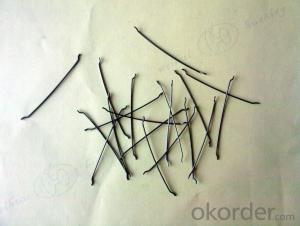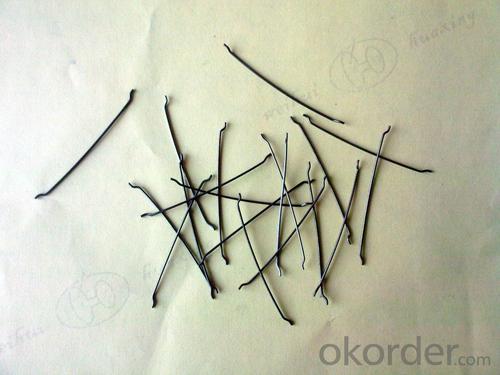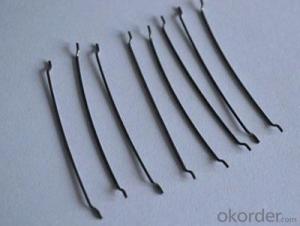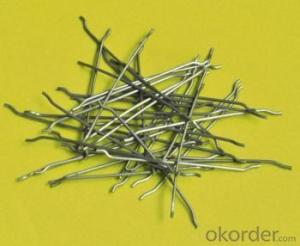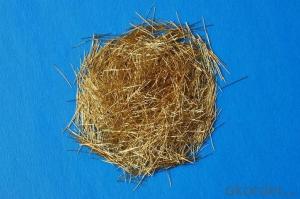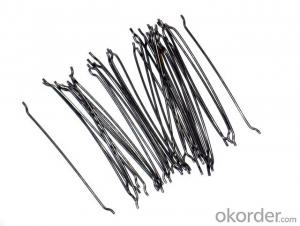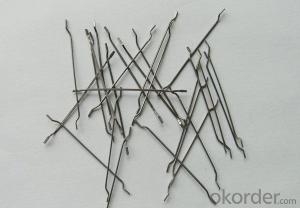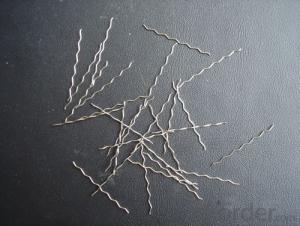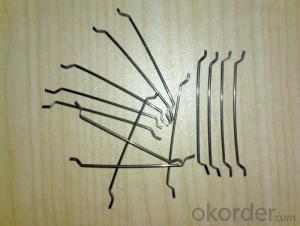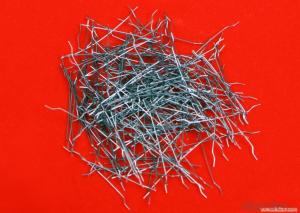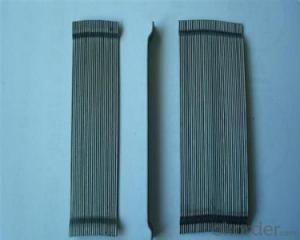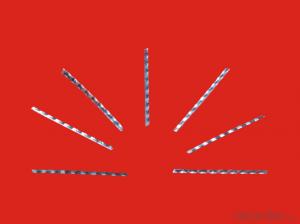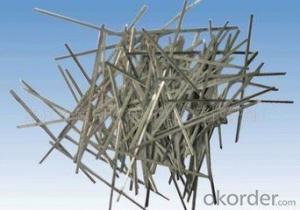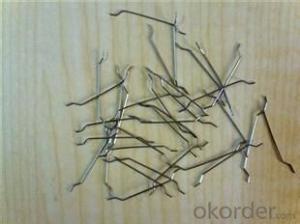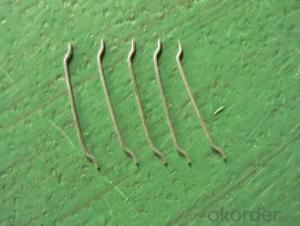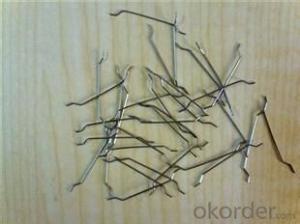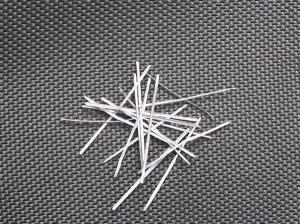Melt Extract Stainless Steel Fiber - Steel Fiber Loose CNBM Company China
- Loading Port:
- Tianjin
- Payment Terms:
- TT OR LC
- Min Order Qty:
- 2000 kg
- Supply Capability:
- 30000 kg/month
OKorder Service Pledge
OKorder Financial Service
You Might Also Like
Quick Details
Place of Origin: Jiangsu, China (Mainland)
Model Number: HT-MC
Material: Color Steel
certificated: ISO 9001
Specifications
1.material: steel plate
2.shape: waved
3.thickness: 0.5-13mm
4.length:35-5mm
5.tensile strength: >800Mpa
Xorex Steel Fiber
The milled steel fiber is made of high-strength steel wire through milling process, which makes the wire into wave shape to increase the touching area with concrete. By tightly binding with the mortar, the steel fiber can greatly enhance the performance of steel-fiber reinforced concrete, with strong cracking and shearing resistance, and tensile strength.
Specification | Thickness (mm) | Width (mm) | Length (mm) | Length- diameter l/d | Tensile strength (MPa) | Bending property |
T×W×L | 0.5-1.3 | 2-4 | 35-50 | 70~38 | ≥600 | ≥3 |
Item | Ordinary concrete | Steel fiber reinforced concrete | Enhancement rate |
C30(RC) | C30(SFRC) | (,%,) | |
Tensile strength | 3,5MPa | 5,39-7MPa | 54-100 |
Compressive strength | 31,2MPa | 32,5-40MPa | 4,4-28,2 |
Ultimate bending strength | 5,5MPa | 9,18-13,75MPa | 67-520 |
First crack bending strength | 4,88MPa | 7-8Mpa | 43-100 |
First crack strength | 8,85N,m | 23-53N,m | 160-500 |
Impact and fatigue strength | 5,96/cm2 | 53,3-91/m2 | 8-15 times |
Impermeability grade | P6~p12 | 0,5 ~2,5 times |
Type of steel fiber reinforced concrete | length/mm | L/D |
For general purpose | 20~60 | 30~80 |
Jet concrete | 20~35 | 30~80 |
Joints of seismic frame | 35~60 | 50~80 |
Railway sleeper | 30~35 | 50~70 |
Layered composite pavement | 30~120 | 60~100 |
Content of steel fiber | Sand percentage (%) | Water cement ratio | Slump (cm) | Unit amount (kg/m3) | ||||
Steel fiber | Cement | Gravel | Sand | Water | ||||
1—1.2 | 40 | 0.45 | 3—5 | 78 | 400 | 1233 | 819 | 180 |
Content of steel fiber | Sand percentage (%) | Water cement ratio | Slump (cm) | Unit amount (kg/m3) | ||||
Steel fiber | Cement | Gravel | Sand | Water | ||||
1.5—1.8 | 48 | 0.45 | 3—5 | 120 | 450 | 1210 | 1035 | 200 |
Picture
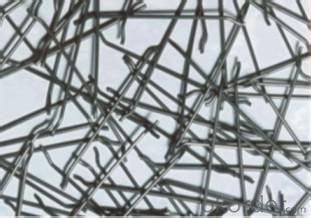
Steel fiber
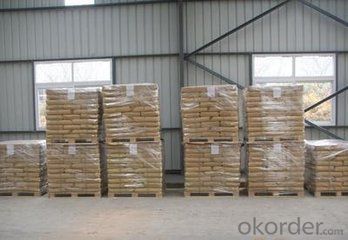

FAQ
certificated: ISO 9001
Technical advantages of Daye steel fiber:
A. Improve mechanical performance of concrete
B. Provide uniform distribution throughout concrete with excellent mixing
C. No balling or caking by adopt correct mixing method
D. Reduce concrete volume
E.Save construction time and cost
F.Reduce excavation volume
G.Available for jointless floor.
- Q: Is melt extract stainless steel fiber compatible with all types of aggregate?
- Melt extract stainless steel fiber is not universally compatible with all types of aggregate, I'm afraid. The compatibility relies on a variety of factors, including the aggregate's composition, characteristics, and the specific properties and requirements of the application. To achieve the desired performance, it is crucial to carefully consider the bonding, dispersion, and overall effectiveness of the fiber and aggregate combination. Seeking guidance from experts or manufacturers is highly advised to determine the compatibility of melt extract stainless steel fiber with different aggregate types for specific applications.
- Q: How does the addition of melt extract stainless steel fiber affect the durability of concrete?
- The addition of melt extract stainless steel fiber significantly improves the durability of concrete. The fibers enhance the tensile strength and crack resistance of concrete, reducing the risk of cracking and enhancing its overall durability. They also help to control shrinkage and improve the resistance to impact, abrasion, and corrosion. Overall, the addition of melt extract stainless steel fiber greatly enhances the durability and lifespan of concrete structures.
- Q: Can melt extract stainless steel fiber be used in the construction of water treatment facilities?
- Yes, melt extract stainless steel fiber can be used in the construction of water treatment facilities. Stainless steel fibers are known for their high corrosion resistance, durability, and strength, making them suitable for various applications in water treatment facilities. These fibers can be used in concrete structures to enhance their mechanical properties and resistance to cracking, which is crucial in the construction of water treatment plants where exposure to water and chemicals is common. The stainless steel fibers can also help in preventing the formation of cracks due to shrinkage and thermal stresses, ensuring the long-term integrity and performance of the facility. Additionally, the use of stainless steel fibers can improve the overall structural performance, as well as provide enhanced resistance to abrasion and erosion caused by the movement of water and particles within the treatment processes. Therefore, melt extract stainless steel fiber can be a valuable material in the construction of water treatment facilities.
- Q: What is the mechanism of steel fiber spacing enhancement?
- At the same time, the crystal structure is formed by the rapid quenching of the fiber during the process of pumping. The structure makes the fiber obtain high elongation and high tensile strength
- Q: What is the impact of melt extract stainless steel fiber on the early-age cracking of concrete?
- The impact of melt extract stainless steel fiber on the early-age cracking of concrete is significant. Stainless steel fiber is a type of reinforcement that is added to concrete mixtures to enhance its tensile strength and prevent cracking. Early-age cracking refers to the cracks that develop in concrete during the initial stages of curing, which can weaken the structure and affect its durability. When melt extract stainless steel fibers are incorporated into concrete, they act as a reinforcement by dispersing uniformly throughout the mixture. This reinforcement improves the overall strength and ductility of concrete, making it more resistant to cracking. The stainless steel fibers also provide additional tensile strength, which is particularly important during the early-age stage when concrete is still gaining strength. One of the main causes of early-age cracking is the rapid drying of the concrete, which leads to shrinkage. Stainless steel fibers help mitigate this issue by reducing the shrinkage and improving the overall dimensional stability of the concrete. This is due to the fibers' ability to effectively distribute the stress and restrain the movement of the concrete matrix. Furthermore, the melt extract stainless steel fibers also enhance the bond between the cementitious matrix and the aggregates, resulting in improved interfacial transition zone (ITZ). This strengthened ITZ reduces the vulnerability of the concrete to cracking, especially during the early stages when the bond between the matrix and aggregates is still developing. In summary, the incorporation of melt extract stainless steel fiber in concrete has a positive impact on the early-age cracking of concrete. It improves the tensile strength, ductility, dimensional stability, and bond strength, all of which contribute to reducing and preventing early-age cracking. This reinforcement ultimately enhances the overall durability and longevity of concrete structures.
- Q: Can melt extract stainless steel fiber be used in architectural precast cladding?
- Yes, melt extract stainless steel fiber can be used in architectural precast cladding. Stainless steel fibers are commonly used in architectural applications due to their high strength, durability, and corrosion resistance. These fibers can enhance the performance of precast cladding by improving its tensile and flexural strength, reducing cracking, and enhancing its resistance to impact and abrasion. Additionally, stainless steel fibers offer design flexibility and can be easily incorporated into the concrete mix without affecting its workability. Overall, the use of melt extract stainless steel fiber in architectural precast cladding can improve the longevity and performance of the cladding system.
- Q: How does melt extract stainless steel fiber improve the durability of concrete?
- Melt extract stainless steel fiber improves the durability of concrete in several ways. Firstly, the addition of stainless steel fibers to concrete enhances its tensile strength and flexural properties. This means that the concrete becomes more resistant to cracking and can withstand higher levels of stress and load. The fibers act as reinforcement within the concrete matrix, effectively bridging any cracks that may occur and preventing them from propagating further. Moreover, stainless steel fibers also improve the impact resistance of concrete. The fibers absorb and distribute the impact energy, reducing the likelihood of surface spalling or fragmentation. This makes the concrete more durable and able to withstand heavy impacts or dynamic loading conditions. Additionally, stainless steel fibers enhance the resistance of concrete to corrosion. These fibers are made from stainless steel, which is highly resistant to rust and other forms of corrosion. By incorporating stainless steel fibers into the concrete mix, it creates a protective barrier against aggressive chemicals, moisture, and other environmental factors that can cause corrosion and deterioration. This significantly extends the lifespan of the concrete structure and reduces the need for costly repairs or replacements. In summary, melt extract stainless steel fiber improves the durability of concrete by enhancing its tensile strength, flexural properties, impact resistance, and corrosion resistance. This ultimately leads to a longer-lasting and more resilient concrete structure that can withstand harsh conditions and heavy use.
- Q: What is the effect of melt extract stainless steel fiber on the toughness of concrete?
- The effect of melt extract stainless steel fiber on the toughness of concrete is that it significantly improves the concrete's toughness and durability. The stainless steel fibers enhance the crack resistance and prevent crack propagation, resulting in a more resilient and long-lasting concrete structure.
- Q: Can melt extract stainless steel fiber be used in the construction of offshore platforms?
- Yes, melt extract stainless steel fiber can be used in the construction of offshore platforms. It is a durable and corrosion-resistant material that can enhance the strength and integrity of the structure, making it suitable for harsh marine environments.
- Q: How does melt extract stainless steel fiber improve the durability of marine concrete?
- Melt extract stainless steel fiber improves the durability of marine concrete through several key mechanisms. Firstly, the addition of stainless steel fibers enhances the overall strength and toughness of the concrete, making it more resistant to cracking and spalling under the harsh conditions of the marine environment. These fibers act as reinforcement, providing additional tensile strength to the concrete matrix and preventing the propagation of cracks. Furthermore, the corrosion resistance of stainless steel fibers is a crucial factor in improving the durability of marine concrete. The presence of saltwater and chloride ions in marine environments can cause significant corrosion to traditional reinforcement materials like steel bars. However, stainless steel fibers are highly resistant to corrosion, ensuring the long-term integrity and durability of the concrete structure. Another important benefit of melt extract stainless steel fiber is its ability to enhance the resistance of marine concrete to impact and abrasion. The fibers act as a sacrificial layer, absorbing and dissipating the energy of impacts, such as waves or floating debris, which could otherwise cause damage to the concrete surface. This results in a more durable concrete structure that can withstand the harsh conditions of marine environments over an extended period. In addition to these mechanical properties, melt extract stainless steel fiber also improves the durability of marine concrete by reducing shrinkage and improving the overall dimensional stability. This is particularly important in marine applications where the concrete is exposed to wet-dry cycles and extreme temperature variations. By minimizing shrinkage and reducing the potential for cracking, stainless steel fibers contribute to the longevity of the concrete structure. Overall, the incorporation of melt extract stainless steel fiber in marine concrete significantly enhances its durability by improving strength, corrosion resistance, impact resistance, and dimensional stability. These properties ensure that the concrete can withstand the demanding conditions of marine environments, leading to longer service life and reduced maintenance costs.
Send your message to us
Melt Extract Stainless Steel Fiber - Steel Fiber Loose CNBM Company China
- Loading Port:
- Tianjin
- Payment Terms:
- TT OR LC
- Min Order Qty:
- 2000 kg
- Supply Capability:
- 30000 kg/month
OKorder Service Pledge
OKorder Financial Service
Similar products
Hot products
Hot Searches
Related keywords
